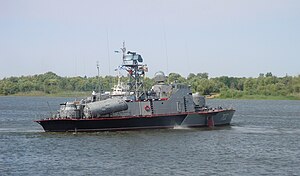
Poti is a port city in Georgia, located on the eastern Black Sea coast in the region of Samegrelo-Zemo Svaneti in the west of the country. Built near the site of the ancient Greek colony of Phasis and deriving its name from the same, the city has become a major port city and industrial center since the early 20th century. It is also home to a main naval base and the headquarters of the Georgian Navy.
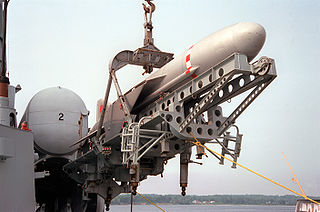
The P-15 Termit is an anti-ship missile developed by the Soviet Union's Raduga design bureau in the 1950s. Its GRAU designation was 4K40, its NATO reporting name was Styx or SS-N-2. China acquired the design in 1958 and created at least four versions: the CSS-N-1 Scrubbrush and CSS-N-2 versions were developed for ship-launched operation, while the CSS-C-2 Silkworm and CSS-C-3 Seersucker were used for coastal defence. Other names for this basic type of missile include: HY-1, SY-1, and FL-1 Flying Dragon, North Korean local produced KN-1 or KN-01, derived from both Silkworm variants and Russian & USSR P-15, Rubezh, P-20 P-22.

The Pegasus-class hydrofoils were a series of fast attack patrol boats employed by the United States Navy. They were in service from 1977 until 1993. These hydrofoils carried the designation "PHM" for "Patrol Hydrofoil, Missile." The Pegasus-class vessels were originally intended for NATO operations in the North Sea and Baltic Sea. Subsequently, participation by other NATO navies, including Germany and Italy, ceased and the U.S. Navy proceeded to procure six PHMs, which were highly successful in conducting coastal operations, such as narcotics interdiction and coastal patrol, in the Caribbean basin.

The Soviet designation Project 1241 Molniya are a class of Russian missile corvettes. They have the NATO reporting name Tarantul. These ships were designed to replace the Project 205M Tsunami missile cutter.

The Black Sea Fleet is the fleet of the Russian Navy in the Black Sea, the Sea of Azov and the Mediterranean Sea. The Black Sea Fleet, along with other Russian ground and air forces on the Crimean Peninsula, are subordinate to the Southern Military District of the Russian Armed Forces.

The Slava class, Soviet designation Project 1164 Atlant, is a class of guided-missile cruisers designed and constructed in the Soviet Union for the Soviet Navy, and currently operated by the Russian Navy.

The Koni class is the NATO reporting name for an anti-submarine warfare frigate built by the Soviet Union. They were known in the Soviet Union as Project 1159. 14 were built in Zelenodolsk shipyard between 1975 and 1988. They were originally intended to replace the older Riga-class frigates, but were instead chosen as a design for export to various friendly navies. The Koni I sub class were designed for European waters and the Koni II were made for warmer waters. One ship was retained by the Soviets in the Black Sea for training foreign crews. Only a few of these vessels remain in service today.

The Nanuchka class, Soviet designation Project 1234 Ovod, are series of corvettes built for the Soviet Navy and export customers between 1969 and 1991.

The Project 205 Moskit (mosquito) more commonly known by their NATO reporting name Osa, are a class of missile boats developed for the Soviet Navy in the late 1950s. Until 1962 this was classified as a large torpedo boat.

The Georgian Coast Guard is the maritime arm of the Georgian Border Police, within the Ministry for Internal Affairs. It is responsible for the maritime protection of the entire 310 km (190 mi) coastline of Georgia, as well as the Georgian territorial waters. The primary missions of the service are administration of the territorial waters, marine pollution protection, maritime law enforcement, search and rescue, port security and maritime defense. The former Georgian Navy was absorbed into the Coast Guard in 2009.
The Black Sea Campaigns were the operations of the Axis and Soviet naval forces in the Black Sea and its coastal regions during World War II between 1941 and 1944, including in support of the land forces.
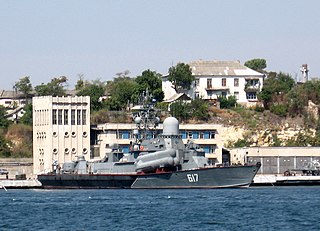
The Skirmish off the coast of Abkhazia was a naval engagement between warships of the Russian Black Sea Fleet of the Russian Navy and the Georgian Navy during the Russo-Georgian War.

The Sparviero class, also known as the Nibbio class, are small hydrofoil missile boats capable of traveling at speeds of 46 knots. They were designed for and formerly used by the Italian Navy. The Japanese 1-go-class missile boat is an updated version formerly used by the Japan Maritime Self-Defense Force (JMSDF).

The Soviet Project 183R class, more commonly known as the Komar class, its NATO reporting name, meaning "mosquito", is a class of missile boats, the first of its kind, built in the 1950s and 1960s. Notably, they were the first to sink another ship with anti-ship missiles in 1967.
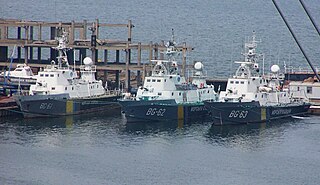
The Stenka class is the NATO reporting name for a class of patrol boats built for the Soviet Navy and Soviet Allies. The Soviet designation was Project 205P Tarantul. The boats are an anti-submarine (ASW) patrol boat version of the Osa-class missile boat.

The Sarancha class is the NATO reporting name for a hydrofoil missile boat built for the Soviet Navy. The Soviet designation was Project 1240 Uragan.
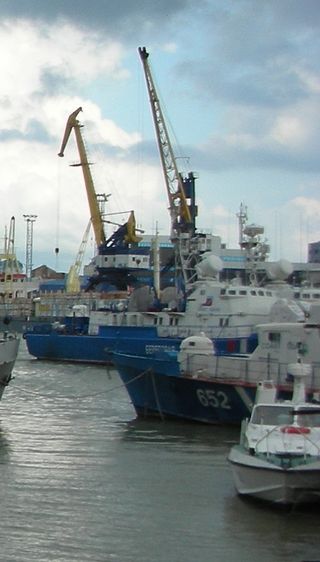
The Muravey-class is the NATO reporting name for a class of hydrofoil patrol boats built for the Soviet Navy between 1983 and 1989. The Soviet designation was Project 133 Antares.

The Svetlyak class, Russian designation Project 10410 Svetlyak, is a class of patrol boats designed and built in the Soviet Union and later in Russia, and currently being used primarily by the Russian Navy and Russian Coast Guard.

Hetman Ivan Mazepa (F211) is an Ada-class anti-submarine corvette of the Ukrainian Navy currently in the process of fitting out. The ship is named after Ivan Mazepa, a Ukrainian Cossack leader who turned against the Tsardom of Russia of Peter the Great and joined the side of Charles XII of Sweden during the Swedish Invasion of Russia.
